Initial Example
We will start with a simple example of a protocol that consists of just two messages, written here in so-called Alice-and-Bob notation:
C -> S: aenc(k, pkS)
C <- S: h(k)In this protocol, a client C generates a fresh
symmetric key k, encrypts it with the public key
pkS of a server S (aenc
stands for asymmetric encryption), and sends it to
S. The server confirms the key’s receipt by sending
the hash of the key back to the client.
This simple protocol is artificial and satisfies only very weak security guarantees. We will use it to illustrate the general Tamarin workflow by proving that, from the client’s perspective, the freshly generated key is secret provided that the server is not compromised. By default, the adversary is a Dolev-Yao adversary that controls the network and can delete, inject, modify and intercept messages on the network.
The protocol’s Tamarin model and its security properties are
given in the file FirstExample.spthy
(.spthy stands for security protocol
theory), which can be found in the folder code
within the github repository of this tutorial (https://github.com/tamarin-prover/manual). The
Tamarin file starts with theory followed by the
theory’s name, here FirstExample.
theory FirstExample
beginAfter the keyword begin, we first declare the
cryptographic primitives the protocol uses. Afterward, we declare
multiset rewriting rules that model the protocol, and finally we
write the properties to be proven (called lemmas within
the Tamarin framework), which specify the protocol’s desired
security properties. Note that we have also inserted comments to
structure the theory.
We next explain in detail the protocol model.
Cryptographic primitives
We are working in a symbolic model of security protocols. This means that we model messages as terms, built from functions that satisfy an underlying equational theory describing their properties. This will be explained in detail in the part on Cryptographic Messages.
In this example, we use Tamarin’s built-in functions for hashing and asymmetric-encryption, declared in the following line:
builtins: hashing, asymmetric-encryptionThese built-ins give us
- a unary function
h, denoting a cryptographic hash function - a binary function
aencdenoting the asymmetric encryption algorithm, - a binary function
adecdenoting the asymmetric decryption algorithm, and - a unary function
pkdenoting the public key corresponding to a private key.
Moreover the built-in also specifies that the decryption of the
ciphertext using the correct private key returns the initial
plaintext, i.e., adec(aenc(m, pk(sk)), sk) is reduced
to m.
Modeling a Public Key Infrastructure
In Tamarin, the protocol and its environment are modeled using
multiset rewriting rules. The rules operate on the
system’s state, which is expressed as a multiset (i.e., a bag) of
facts. Facts can be seen as predicates storing state information.
For example, the fact Out(h(k)) models that the
protocol sent out the message h(k) on the public
channel, and the fact In(x) models that the protocol
receives the message x on the public channel. 1
The example starts with the model of a public key
infrastructure (PKI). Again, we use facts to store information
about the state given by their arguments. The rules have a premise
and a conclusion, separated by the arrow symbol
-->. Executing the rule requires that all facts in
the premise are present in the current state and, as a result of
the execution, the facts in the conclusion will be added to the
state, while the premises are removed. Now consider the first
rule, modeling the registration of a public key:
rule Register_pk:
[ Fr(~ltk) ]
-->
[ !Ltk($A, ~ltk), !Pk($A, pk(~ltk)) ]Here the only premise is an instance of the Fr
fact. The Fr fact is a built-in fact that denotes a
freshly generated name. This mechanism is used to model random
numbers such as nonces or keys (see Model
Specification for details).
In Tamarin, the sort of a variable is expressed using prefixes:
~xdenotesx:fresh$xdenotesx:pub%xdenotesx:nat#idenotesi:temporalmdenotesm:msg
Moreover, a string constant 'c' denotes a public
name in pub, which is a fixed, global constant. We
have a top sort msg and three incomparable subsorts
fresh, pub and nat of that
top sort. Timepoint variables of sort temporal are
unconnected.
The above rule can therefore be read as follows. First,
generate a fresh name ~ltk (of sort fresh), which is
the new private key, and non-deterministically choose a public
name A, for the agent for whom we are generating the
key-pair. Afterward, generate the fact !Ltk($A, ~ltk)
(the exclamation mark ! denotes that the fact is
persistent, i.e., it can be consumed arbitrarily often), which
denotes the association between agent A and its
private key ~ltk, and generate the fact
!Pk($A, pk(~ltk)), which associates agent
A and its public key pk(~ltk).
In the example, we allow the adversary to retrieve any public
key using the following rule. Essentially, it reads a public-key
database entry and sends the public key to the network using the
built-in fact Out, which denotes sending a message to
the network (see the section on Model
Specification for more information).
rule Get_pk:
[ !Pk(A, pubkey) ]
-->
[ Out(pubkey) ]We model the dynamic compromise of long-term private keys using
the following rule. Intuitively, it reads a private-key database
entry and sends it to the adversary. This rule has an observable
LtkReveal action stating that the long-term key of
agent A was compromised. Action facts are just like
facts, but unlike the other facts do not appear in state, but only
on the trace. The security properties are specified on the traces,
and the action LtkReveal is used below to determine
which agents are compromised. The rule now has a premise,
conclusion, and action facts within the arrow:
--[ ACTIONFACT ]->:
rule Reveal_ltk:
[ !Ltk(A, ltk) ]
--[ LtkReveal(A) ]->
[ Out(ltk) ]Modeling the protocol
Recall the Alice-and-Bob notation of the protocol we want to model:
C -> S: aenc(k, pkS)
C <- S: h(k)We model it using the following three rules.
// Start a new thread executing the client role, choosing the server
// non-deterministically.
rule Client_1:
[ Fr(~k) // choose fresh key
, !Pk($S, pkS) // lookup public-key of server
]
-->
[ Client_1( $S, ~k ) // Store server and key for next step of thread
, Out( aenc(~k, pkS) ) // Send the encrypted session key to the server
]
rule Client_2:
[ Client_1(S, k) // Retrieve server and session key from previous step
, In( h(k) ) // Receive hashed session key from network
]
--[ SessKeyC( S, k ) ]-> // State that the session key 'k'
[] // was setup with server 'S'
// A server thread answering in one-step to a session-key setup request from
// some client.
rule Serv_1:
[ !Ltk($S, ~ltkS) // lookup the private-key
, In( request ) // receive a request
]
--[ AnswerRequest($S, adec(request, ~ltkS)) ]-> // Explanation below
[ Out( h(adec(request, ~ltkS)) ) ] // Return the hash of the
// decrypted request.Here, the first rule models the client sending its message, while the second rule models it receiving a response. The third rule models the server, both receiving the message and responding in one single rule.
Several explanations are in order. First, Tamarin uses C-style
comments, so everything between /* and
*/ or the line following // is a
comment. Second, we log the session-key setup requests received by
servers using an action to allow the formalization of the
authentication property for the client later.
Modeling security properties
Security properties are defined over traces of the action facts of a protocol execution.
We have two properties that we would like to evaluate. In the
Tamarin framework, properties to be evaluated are denoted by
lemmas. The first of these is on the secrecy of the session key
from the client point of view. The lemma
Client_session_key_secrecy says that it cannot be
that a client has set up a session key k with a
server S and the adversary learned that
k unless the adversary performed a long-term key
reveal on the server S. The second lemma
Client_auth specifies client authentication. This is
the statement that, for all session keys k that the
clients have setup with a server S, there must be a
server that has answered the request or the adversary has
previously performed a long-term key reveal on S.
lemma Client_session_key_secrecy:
" /* It cannot be that a */
not(
Ex S k #i #j.
/* client has set up a session key 'k' with a server'S' */
SessKeyC(S, k) @ #i
/* and the adversary knows 'k' */
& K(k) @ #j
/* without having performed a long-term key reveal on 'S'. */
& not(Ex #r. LtkReveal(S) @ r)
)
"
lemma Client_auth:
" /* For all session keys 'k' setup by clients with a server 'S' */
( All S k #i. SessKeyC(S, k) @ #i
==>
/* there is a server that answered the request */
( (Ex #a. AnswerRequest(S, k) @ a)
/* or the adversary performed a long-term key reveal on 'S'
before the key was setup. */
| (Ex #r. LtkReveal(S) @ r & r < i)
)
)
"Note that we can also strengthen the authentication property to
a version of injective authentication. Our formulation is stronger
than the standard formulation of injective authentication as it is
based on uniqueness instead of counting. For most protocols that
guarantee injective authentication, one can also prove such a
uniqueness claim, as they agree on appropriate fresh data. This is
shown in lemma Client_auth_injective.
lemma Client_auth_injective:
" /* For all session keys 'k' setup by clients with a server 'S' */
( All S k #i. SessKeyC(S, k) @ #i
==>
/* there is a server that answered the request */
( (Ex #a. AnswerRequest(S, k) @ a
/* and there is no other client that had the same request */
& (All #j. SessKeyC(S, k) @ #j ==> #i = #j)
)
/* or the adversary performed a long-term key reveal on 'S'
before the key was setup. */
| (Ex #r. LtkReveal(S) @ r & r < i)
)
)
"To ensure that our lemmas do not just hold vacuously because
the model is not executable, we also include an executability
lemma that shows that the model can run to completion. This is
given as a regular lemma, but with the exists-trace
keyword, as seen in the lemma
Client_session_key_honest_setup below. This keyword
says that the lemma is true if there exists a trace on
which the formula holds; this is in contrast to the previous
lemmas where we required the formula to hold on all
traces. When modeling protocols, such existence proofs are useful
sanity checks.
lemma Client_session_key_honest_setup:
exists-trace
" Ex S k #i.
SessKeyC(S, k) @ #i
& not(Ex #r. LtkReveal(S) @ r)
"Graphical User Interface
How do you now prove that your lemmas are correct? If you execute the command line
tamarin-prover interactive FirstExample.spthyyou will then see the following output on the command line:
GraphViz tool: 'dot'
checking version: dot - graphviz version 2.39.20150613.2112 (20150613.2112). OK.
maude tool: 'maude'
checking version: 2.7. OK.
checking installation: OK.
The server is starting up on port 3001.
Browse to http://127.0.0.1:3001 once the server is ready.
Loading the security protocol theories './*.spthy' ...
Finished loading theories ... server ready at
http://127.0.0.1:3001
21/Jun/2016:09:16:01 +0200 [Info#yesod-core] Application launched @(yesod_83PxojfItaB8w9Rj9nFdZm:Yesod.Core.Dispatch ./Yesod/Core/Dispatch.hs:157:11)At this point, if there were any syntax or wellformedness errors (for example if the same fact is used with different arities an error would be displayed) they would be displayed. See the part on Modeling Issues for details on how to deal with such errors.
However, there are no such errors in our example, and thus the above command will start a web-server that loads all security protocol theories in the same directory as FirstExample.spthy. Point your browser to
and you will see the following welcome screen:
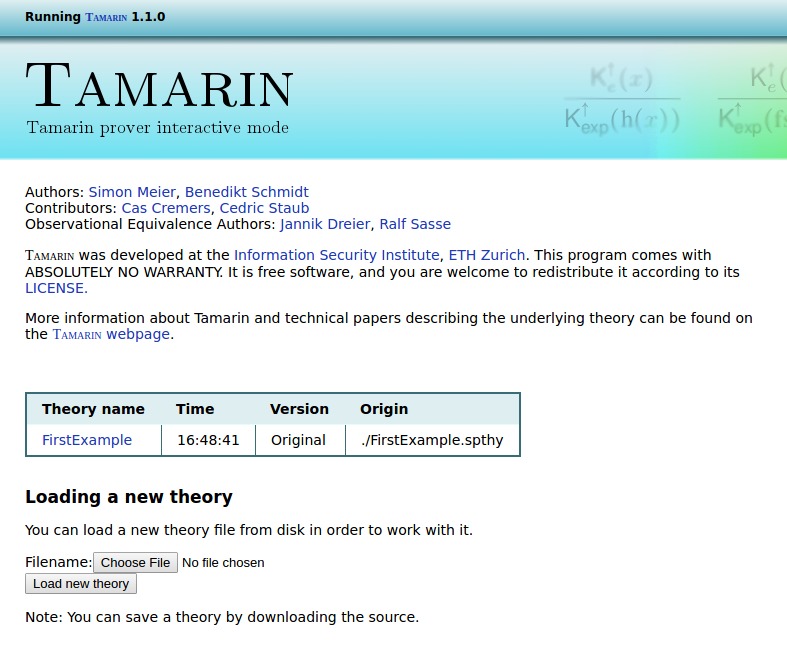
The table in the middle shows all loaded theories. You can either click on a theory to explore it and prove your security properties, or upload further theories using the upload form at the bottom. Do note that no warnings will be displayed if you use the GUI in such a manner to load further theories, so we do recommend starting Tamarin from the command line in the appropriate directory.
If you click on the ‘FirstExample’ entry in the table of loaded theories, you should see the following:
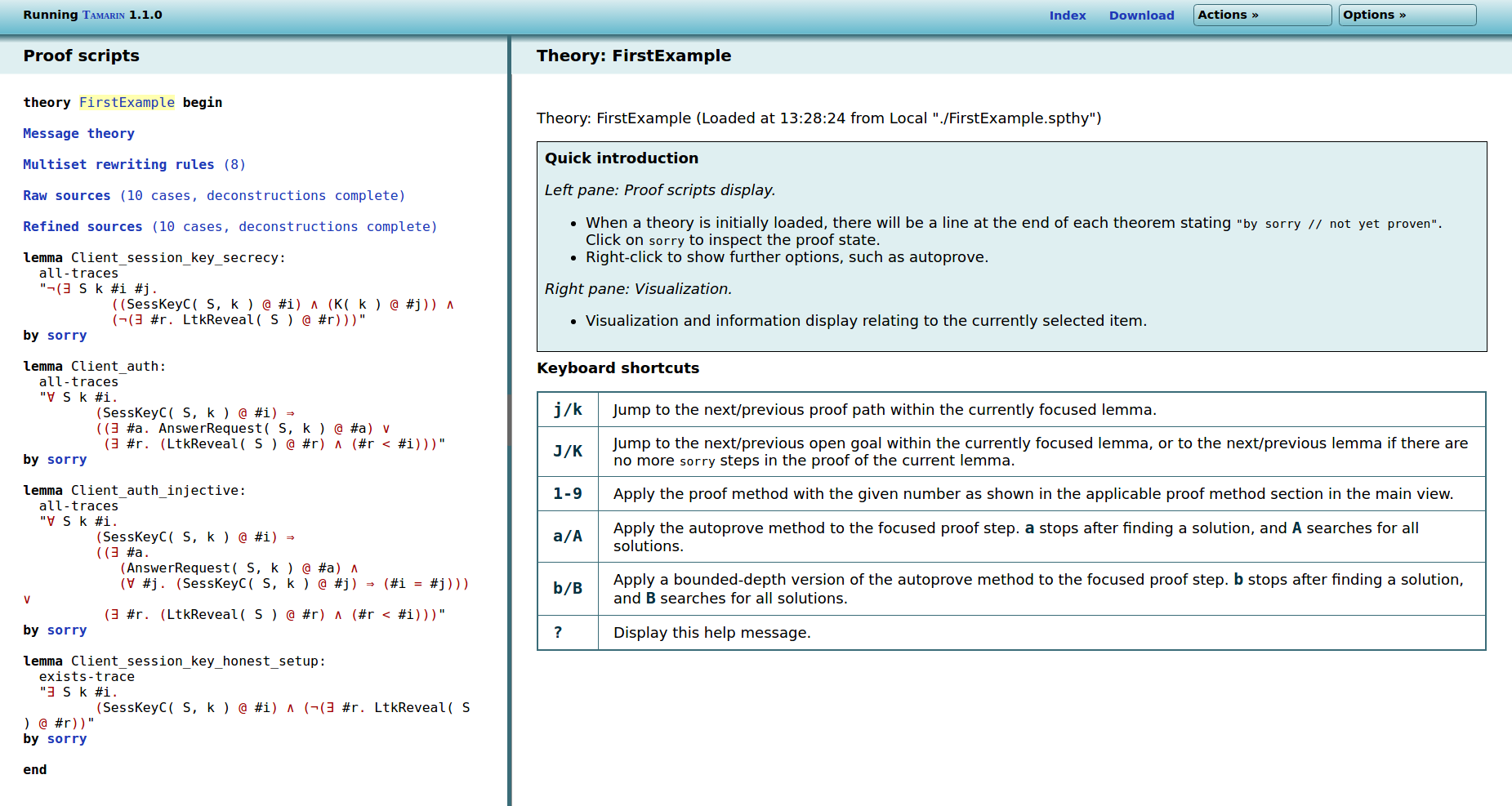
On the left hand side, you see the theory: links to the message theory describing the adversary, the multiset rewrite rules and restrictions describing your protocol, and the raw and refined sources, followed by the lemmas you want to prove. We will explain each of these in the following.
On the right hand side, you have a quick summary of the
available commands and keyboard shortcuts you can use to navigate
inside the theory. In the top right corner there are some links:
Index leads back to the welcome page,
Download allows you to download the current theory
(including partial proofs if they exist), Actions and
the sub-bullet Show source shows the theory’s source
code, and Options allows you to configure the level
of details in the graph visualization (see below for
examples).
If you click on Message theory on the left, you
should see the following:
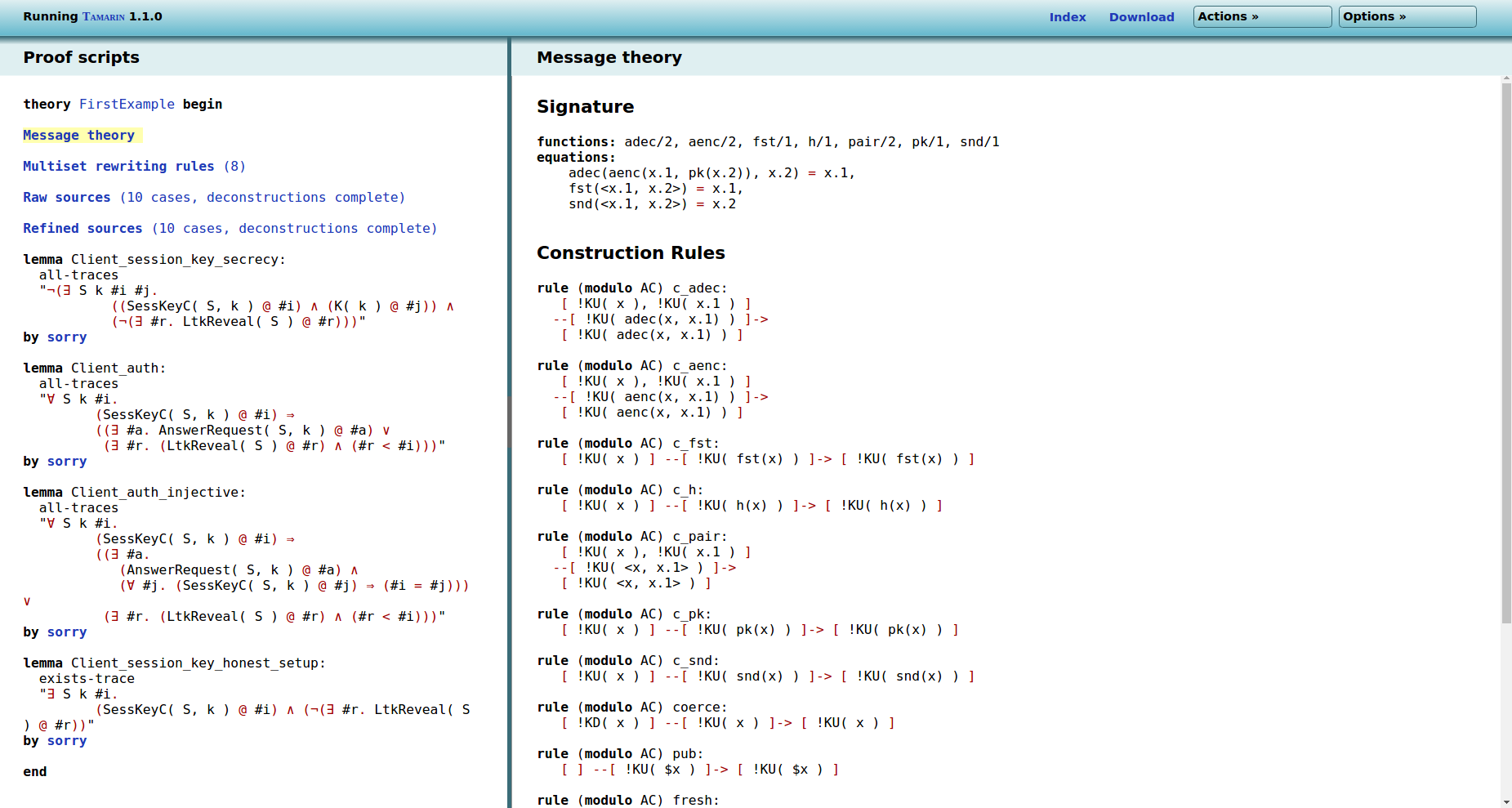
On the right side, you can now see the message theory, starting
with the so-called Signature, which consists of all the
functions and equations. These can be either user-defined or
imported using the built-ins, as in our example. Note that Tamarin
automatically adds a function pair to create pairs,
and the functions fst and snd together
with two equations to access the first and second parts of a pair.
There is a shorthand for the pair using
< and >, which is used here for
example for fst(<x.1, x.2>).
Just below come the Construction rules. These rules describe the functions that the adversary can apply. Consider, for example, the following rule:
rule (modulo AC) ch:
[ !KU( x ) ] --[ !KU( h(x) ) ]-> [ !KU( h(x) ) ]Intuitively, this rule expresses that if the adversary knows
x (represented by the fact !KU(x) in the
premise), then he can compute h(x) (represented by
the fact !KU(h(x)) in the conclusion), i.e., the hash
of x. The action fact !KU(h(x)) in the
label also records this for reasoning purposes.
Finally, there are the Deconstruction rules. These rules describe which terms the adversary can extract from larger terms by applying functions. Consider for example the following rule:
rule (modulo AC) dfst:
[ !KD( <x.1, x.2> ) ] --> [ !KD( x.1 ) ]In a nutshell, this rule says that if the adversary knows the
pair <x.1, x.2> (represented by the fact
!KD( <x.1, x.2> )), then he can extract the
first value x.1 (represented by the fact
!KD( x.1 )) from it. This results from applying
fst to the pair and then using the equation
fst(<x.1, x.2>) = x.1. The precise difference
between !KD( ) and !KU( ) facts is not
important for now, and will be explained below. As a first
approximation, both represent the adversary’s knowledge and the
distinction is only used to make the tool’s reasoning more
efficient.
Now click on Multiset rewriting rules on the left.
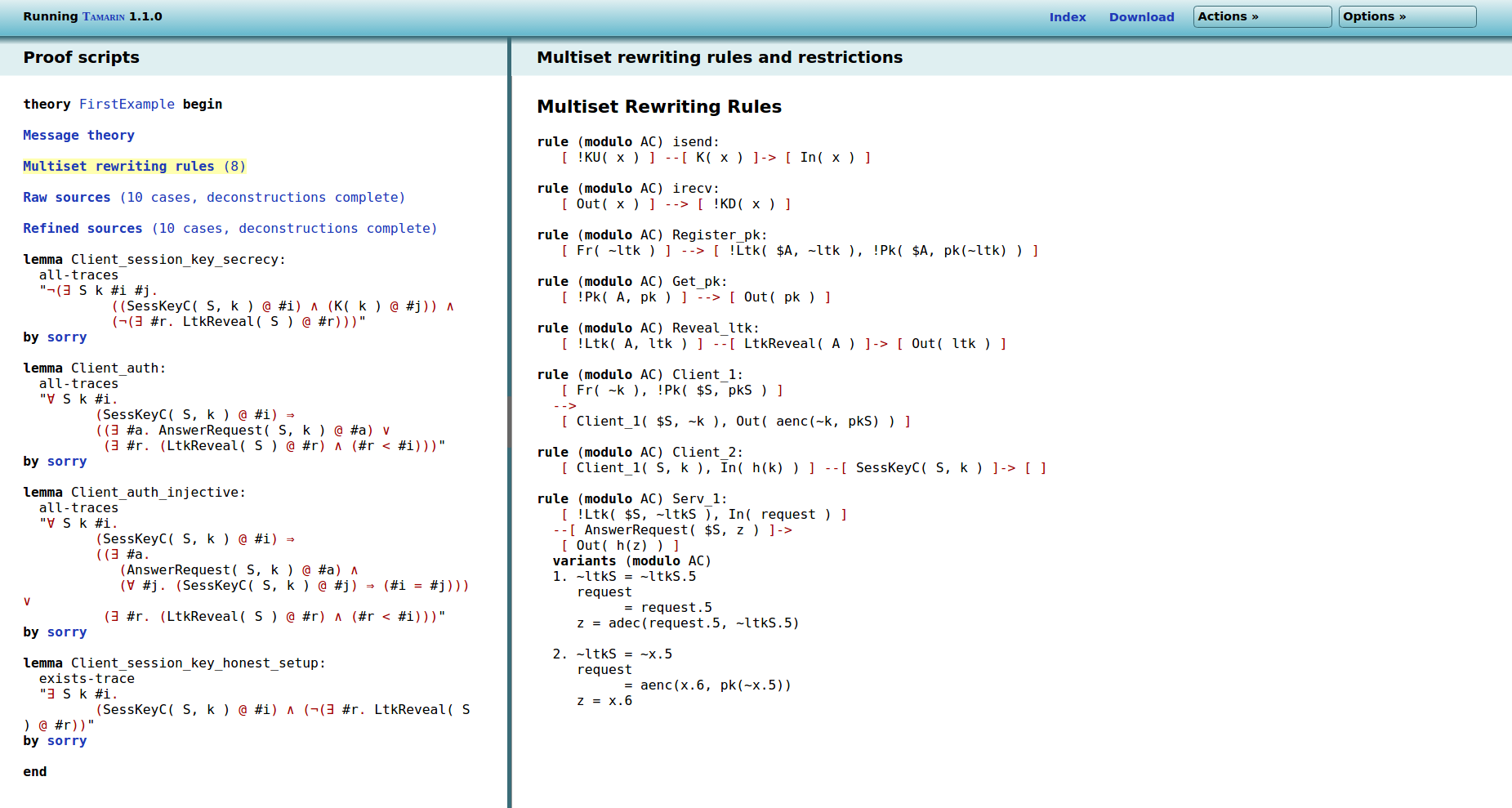
On the right side of the screen are the protocol’s rewriting
rules, plus two additional rules: isend and
irecv2. These two extra rules provide
an interface between the protocol’s output and input and the
adversary deduction. The rule isend takes a fact
!KU(x), i.e., a value x that the
adversary knows, and passes it to a protocol input
In(x). The rule irecv takes a protocol
output Out(x) and passes it to the adversary
knowledge, represented by the !KD(x) fact. Note that
the rule Serv_1 from the protocol has two
variants (modulo AC). The precise meaning of this is
unimportant right now (it stems from the way Tamarin deals with
equations) and will be explained in the section
on cryptographic messages.
Now click on
Refined sources (10 cases, deconstructions complete)
to see the following:
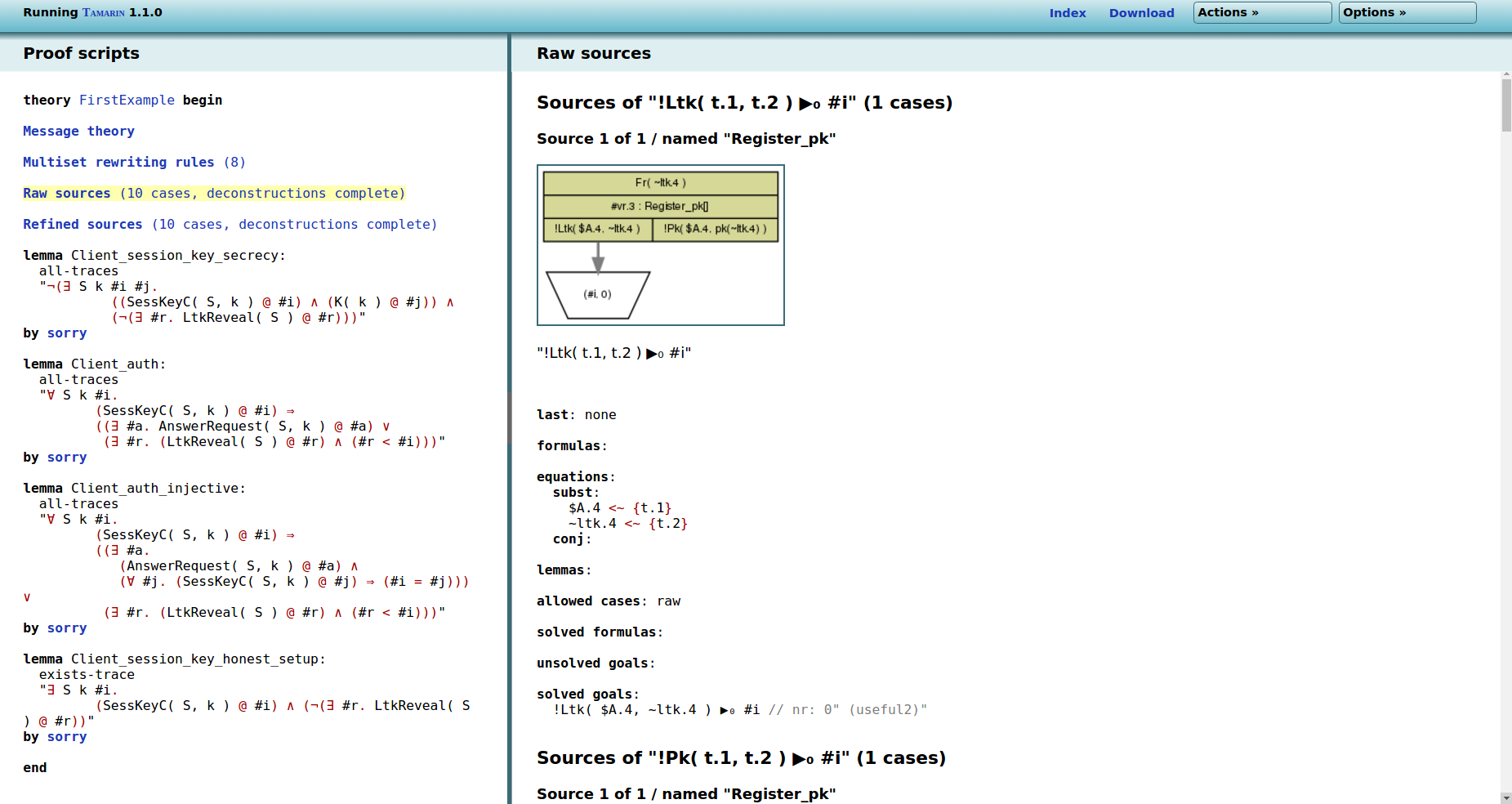
To improve the efficiency of its internal reasoning, Tamarin precomputes case distinctions. A case distinction gives all possible sources for a fact, i.e., all rules (or combinations of rules) that produce this fact, and can then be used during Tamarin’s backward search. These case distinctions are used to avoid repeatedly computing the same things. On the right hand side is the result of the precomputations for our FirstExample theory.
For example, here Tamarin tells us that there is one possible
source of the fact !Ltk( t.1, t.2 ), namely the rule
Register_pk. The image shows the (incomplete) graph
representing the execution. The green box symbolizes the instance
of the Register_pk rule, and the trapezoid on the
bottom stands for the “sink” of the !Ltk( t.1, t.2 )
fact. Here the case distinction consists of only one rule
instance, but there can be potentially multiple rule instances,
and multiple cases inside the case distinction, as in the
following images.
The technical information given below the image is unimportant for now, it provides details about how the case distinction was computed and if there are other constraints such as equations or substitutions that still must be resolved.
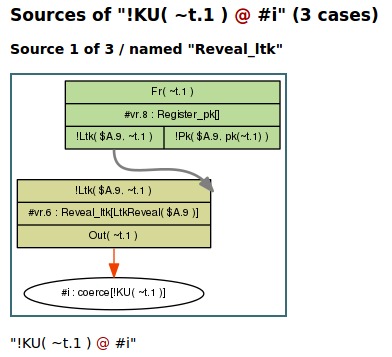
Here the fact !KU( ~t.1 ) has three sources, the
first one is the rule Reveal_ltk, which requires an
instance of the rule Register_pk to create the
necessary !Ltk fact. The other two sources are given
below.
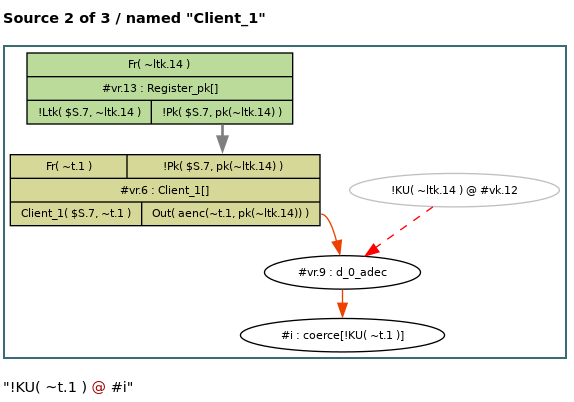
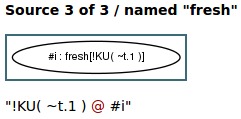
Now we will see how to prove lemmas in the interactive mode.
For that, click on sorry (indicating that the proof
has not been started) after the first lemma in the left frame to
obtain the following screen:
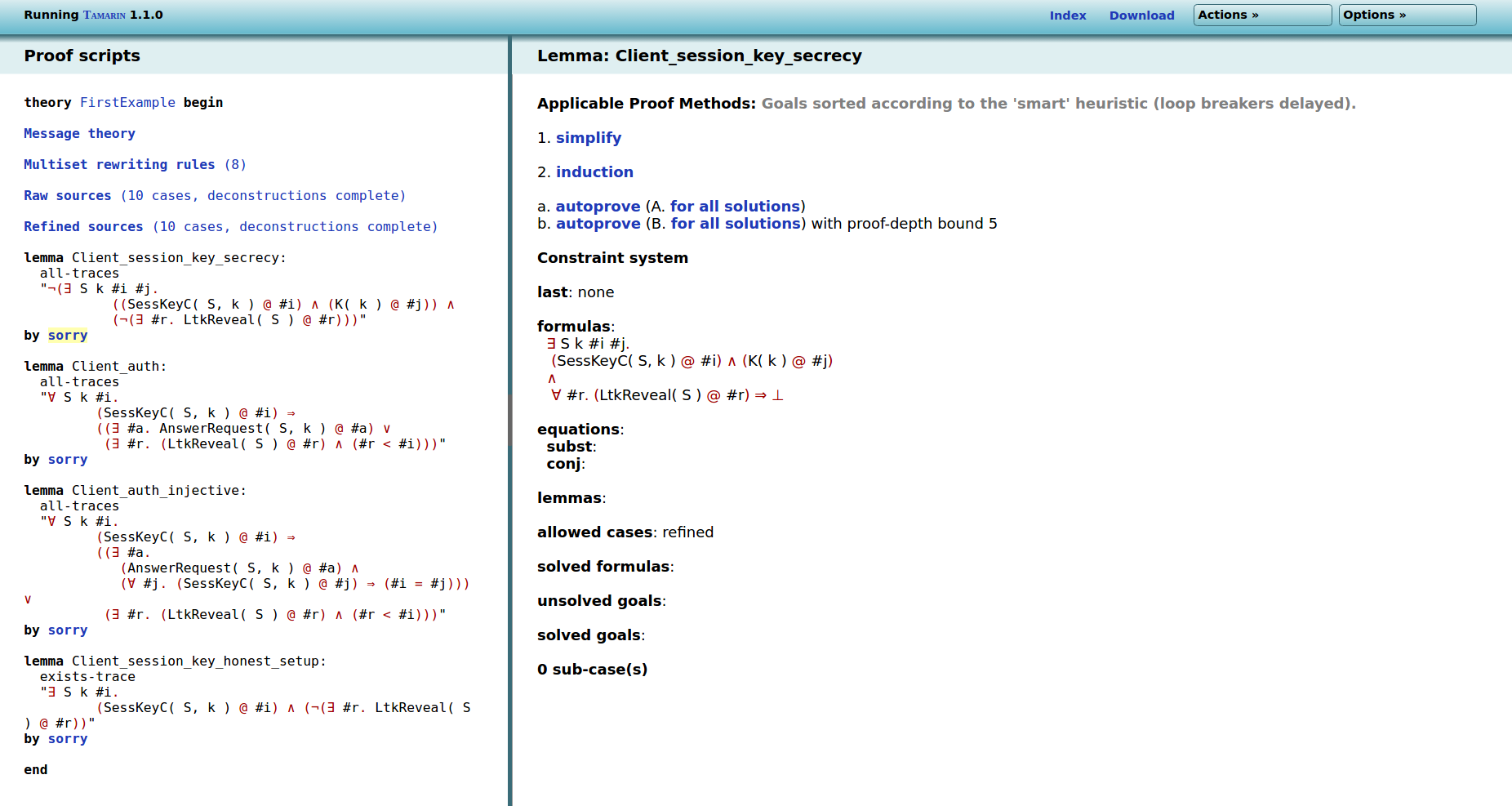
Tamarin proves lemmas using constraint solving. Namely, it refines the knowledge it has about the property and the protocol (called a constraint system) until it can either conclude that the property holds in all possible cases, or until it finds a counterexample to the lemma.
On the right, we now have the possible proof steps at the top,
and the current state of the constraint system just below (which
is empty, as we have not started the proof yet). A proof always
starts with either a simplification step
(1. simplify), which translates the lemma into an
initial constraint system that needs to be resolved, or an
induction setup step (2. induction), which generates
the necessary constraints to prove the lemma using induction on
the length of the trace. Here we use the default strategy, i.e., a
simplification step by clicking on 1. simplify, to
obtain the following screen:
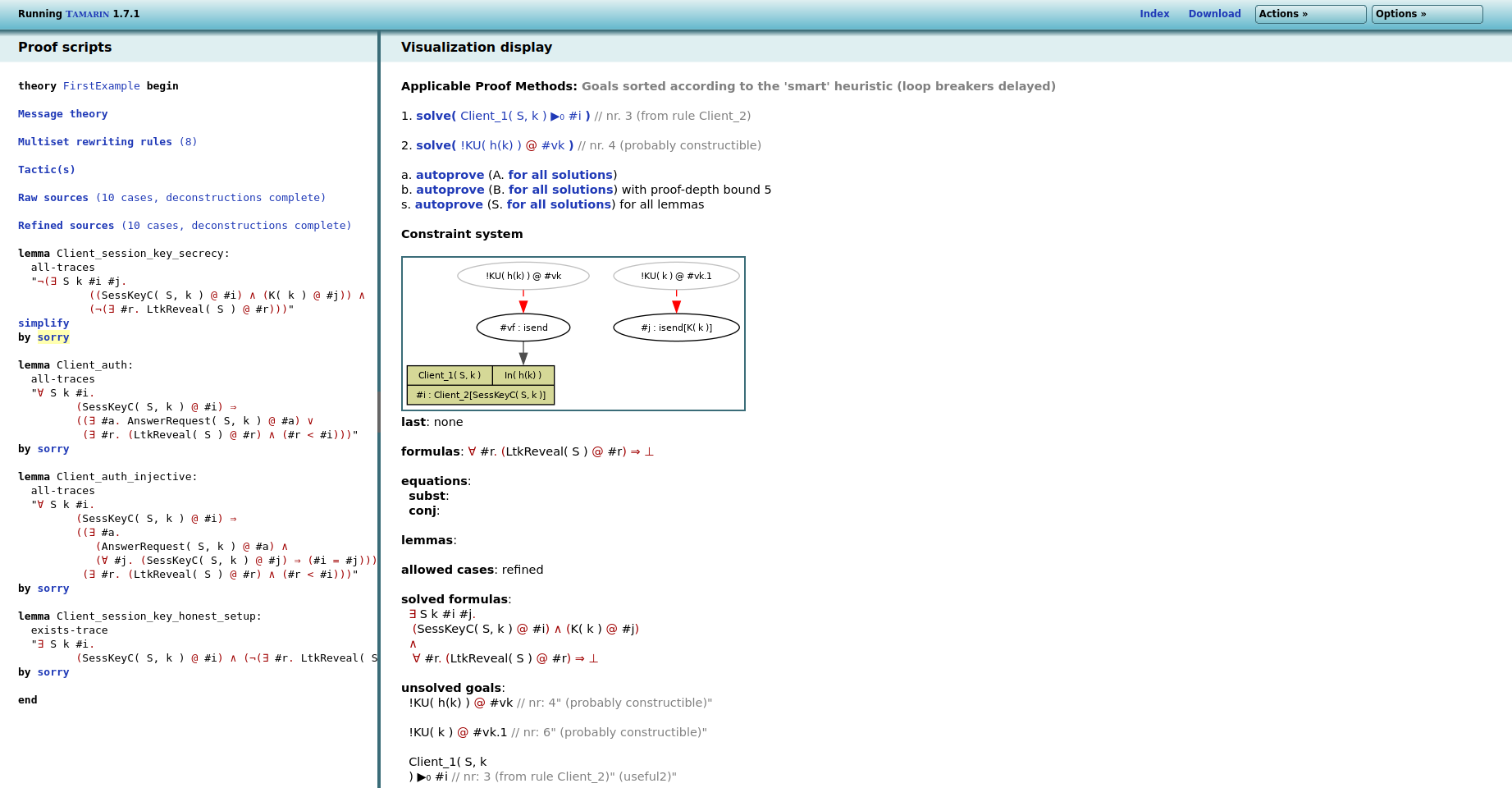
Tamarin has now translated the lemma into a constraint system.
Since Tamarin looks for counterexamples to the lemma, it looks for
a protocol execution that contains a SessKeyC( S, k )
and a K( k ) action, but does not use an
LtkReveal( S ). This is visualized in the graph as
follows. The only way of getting a SessKeyC( S, k )
action is using an instance of the Client_2 rule on
the left, and the K( k ) rule is symbolized on the
right using a round box (adversary reasoning is always visualized
using round boxes). Just below the graph, the formula
formulas: ∀ #r. (LtkReveal( S ) @ #r) ⇒ ⊥now states that any occurrence of LtkReveal( S )
will lead to a contradiction.
To finish the proof, we can either continue manually by
selecting the constraint to resolve next, or by calling the
autoprove command, which selects the next steps based
on a heuristic. Here we have two constraints to resolve:
Client_1( S, k ) and KU( k ), both of
which are premises for the rules in the unfinished current
constraint system.
Note that that the proof methods in the GUI are sorted
according to the same heuristic as is used by the
autoprove command. Any proof found by always
selecting the first proof method will be identical to the one
constructed by the autoprove command. However,
because the general problem is undecidable, the algorithm may not
terminate for every protocol and property.
In this example, both by clicking multiple times on the first
constraint or by using the autoprover, we end with the following
final state, where the constructed graph leads to a contradiction
as it contains LtkReveal( S ):
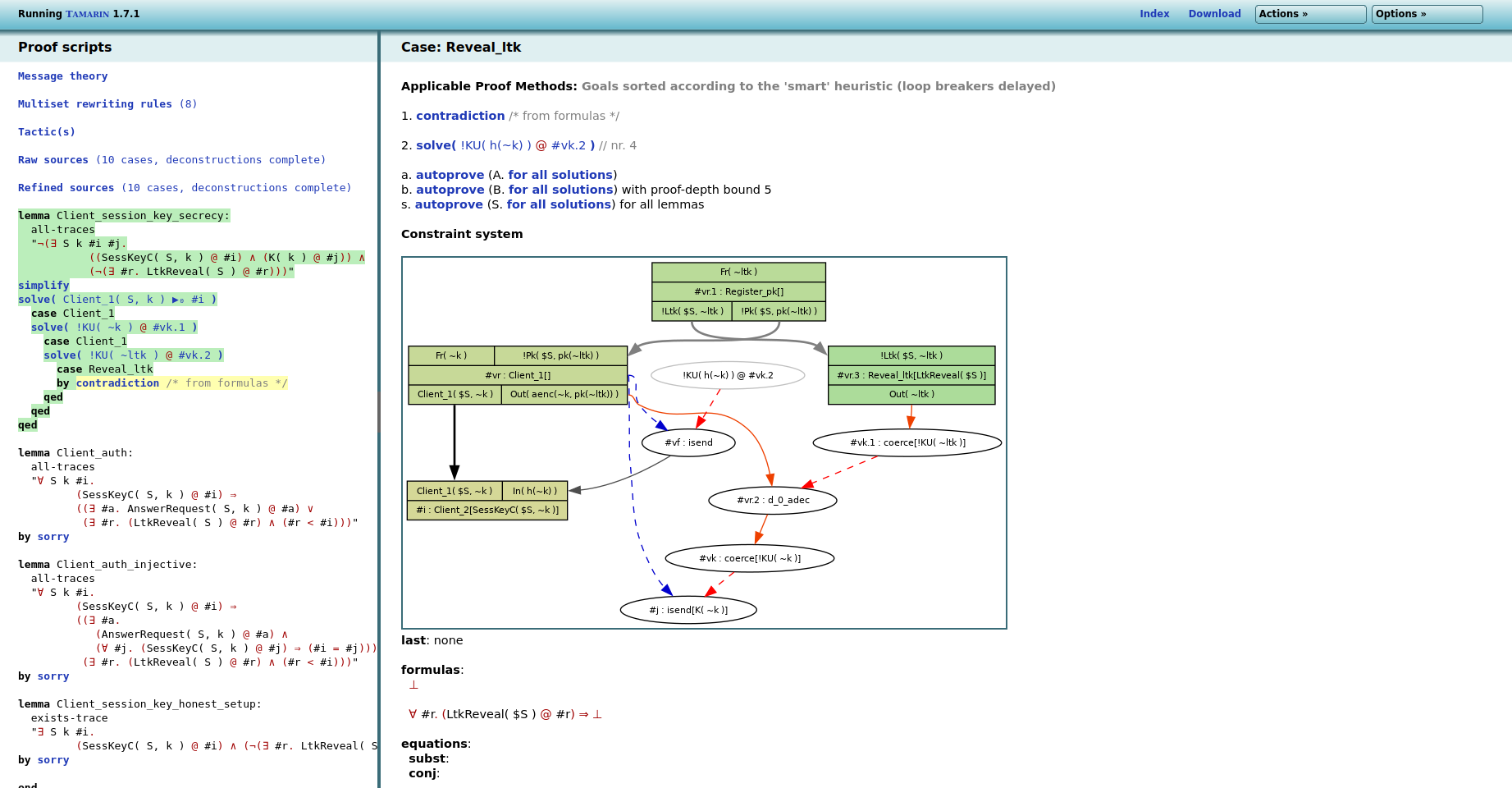
The lemma is now colored in green as it was successfully proven. If we had found a counterexample, it would be colored in red. You can prove the other lemmas in the same way.
As you may have noticed, there can be lots of different types of arrows, which additionally can be colored differently.
There are normal (solid) arrows (in black or gray), which are used to represent the origins of protocol facts (for linear or persistent facts). There are also solid red orange arrows, which represent steps where the adversary extracts values from a message he received.
Then there dashed arrows, representing ordering constraints between two actions, and their colors indicate the reasons for the constraint :
- Black dashed arrows represent an ordering constraint stemming from formulas, for example from the current lemma or a restriction.
- Dark blue indicates an ordering constraint deduced from a fresh value: since fresh values are unique, all rule instances using a fresh value must appear after the instance that created the value.
- Red dashed arrows are used to represent steps where the adversary composes values.
- Dark orange represents an ordering constraint implied by Tamarin’s normal form conditions.
- Purple denotes an ordering constraint originating from an injective fact instance, see injective-instances .
Dashed edges can be colored with multiple colors at a time, which means that there are several ordering constraints at the same time.
For example, a black and blue dashed arrow indicates that there are two constraints: one deduced from a formula, and one deduced from a fresh value appearing in the rule instances.
Finally, in intermediate proof steps, there can also be dotted green arrows, which are used during Tamarin’s proof search to represent incomplete adversary deduction steps.
Note that by default Tamarin does not show all rules and arrows to simplify the graphs, but this can be adjusted using the Options button on the top right of the page.
Running Tamarin on the Command Line
The call
tamarin-prover FirstExample.spthyparses the FirstExample.spthy file, checks its
wellformedness, and pretty-prints the theory. The declaration of
the signature and the equations can be found at the top of the
pretty-printed theory.
Proving all lemmas contained in the theory using the automatic
prover is as simple as adding the flag --prove to the
call; i.e.,
tamarin-prover FirstExample.spthy --proveThis will first output some logging from the constraint solver and then the FirstExample security protocol theory with the lemmas and their attached (dis)proofs:
summary of summaries:
analyzed: FirstExample.spthy
Client_session_key_secrecy (all-traces): verified (5 steps)
Client_auth (all-traces): verified (11 steps)
Client_auth_injective (all-traces): verified (15 steps)
Client_session_key_honest_setup (exists-trace): verified (5 steps)It is possible to select lemmas by having multiple
--prove flags and by specifying a common prefix
followed by a wildcard, e.g., --prove=Client_auth*.
Note: In most shells, the * needs to
be escaped to \*.
Quit on Warning
As referred to in “Graphical User
Interface”, in larger models, one can miss wellformedness
errors (when writing the Tamarin file, and when running the
tamarin-prover): in many cases, the web-server starts
up correctly, making it harder to notice that something’s not
right either in a rule or lemma.
To ensure that your provided .spthy file is free
of any errors or warnings (and to halt pre-processing and other
computation in the case of errors), it can be a good idea to use
the --quit-on-warning flag at the command line.
E.g.,
tamarin-prover interactive FirstExample.spthy --quit-on-warningThis will stop Tamarin’s computations from progressing any further, and leave the error or warning causing Tamarin to stop on the terminal.
Complete Example
Here is the complete input file:
/*
Initial Example for the Tamarin Manual
======================================
Authors: Simon Meier, Benedikt Schmidt
Updated by: Jannik Dreier, Ralf Sasse
Date: June 2016
This file is documented in the Tamarin user manual.
*/
theory FirstExample
begin
builtins: hashing, asymmetric-encryption
// Registering a public key
rule Register_pk:
[ Fr(~ltk) ]
-->
[ !Ltk($A, ~ltk), !Pk($A, pk(~ltk)) ]
rule Get_pk:
[ !Pk(A, pubkey) ]
-->
[ Out(pubkey) ]
rule Reveal_ltk:
[ !Ltk(A, ltk) ]
--[ LtkReveal(A) ]->
[ Out(ltk) ]
// Start a new thread executing the client role, choosing the server
// non-deterministically.
rule Client_1:
[ Fr(~k) // choose fresh key
, !Pk($S, pkS) // lookup public-key of server
]
-->
[ Client_1( $S, ~k ) // Store server and key for next step of thread
, Out( aenc(~k, pkS) ) // Send the encrypted session key to the server
]
rule Client_2:
[ Client_1(S, k) // Retrieve server and session key from previous step
, In( h(k) ) // Receive hashed session key from network
]
--[ SessKeyC( S, k ) ]-> // State that the session key 'k'
[] // was setup with server 'S'
// A server thread answering in one-step to a session-key setup request from
// some client.
rule Serv_1:
[ !Ltk($S, ~ltkS) // lookup the private-key
, In( request ) // receive a request
]
--[ AnswerRequest($S, adec(request, ~ltkS)) ]-> // Explanation below
[ Out( h(adec(request, ~ltkS)) ) ] // Return the hash of the
// decrypted request.
lemma Client_session_key_secrecy:
" /* It cannot be that a */
not(
Ex S k #i #j.
/* client has set up a session key 'k' with a server'S' */
SessKeyC(S, k) @ #i
/* and the adversary knows 'k' */
& K(k) @ #j
/* without having performed a long-term key reveal on 'S'. */
& not(Ex #r. LtkReveal(S) @ r)
)
"
lemma Client_auth:
" /* For all session keys 'k' setup by clients with a server 'S' */
( All S k #i. SessKeyC(S, k) @ #i
==>
/* there is a server that answered the request */
( (Ex #a. AnswerRequest(S, k) @ a)
/* or the adversary performed a long-term key reveal on 'S'
before the key was setup. */
| (Ex #r. LtkReveal(S) @ r & r < i)
)
)
"
lemma Client_auth_injective:
" /* For all session keys 'k' setup by clients with a server 'S' */
( All S k #i. SessKeyC(S, k) @ #i
==>
/* there is a server that answered the request */
( (Ex #a. AnswerRequest(S, k) @ a
/* and there is no other client that had the same request */
& (All #j. SessKeyC(S, k) @ #j ==> #i = #j)
)
/* or the adversary performed a long-term key reveal on 'S'
before the key was setup. */
| (Ex #r. LtkReveal(S) @ r & r < i)
)
)
"
lemma Client_session_key_honest_setup:
exists-trace
" Ex S k #i.
SessKeyC(S, k) @ #i
& not(Ex #r. LtkReveal(S) @ r)
"
endWhen using the default Tamarin setup, there is only one public channel modeling the network controlled by the adversary, i.e., the adversary receives all messages from the
Out( )facts, and generates the protocol’s inputs in theIn( )facts. Private channels can be added if required, see Channel Models for details.↩︎The ‘i’ historically stems from “intruder”, but here we use “adversary”.↩︎